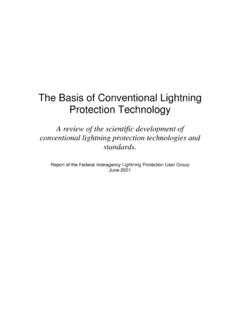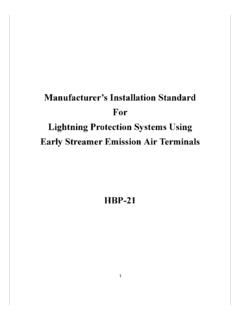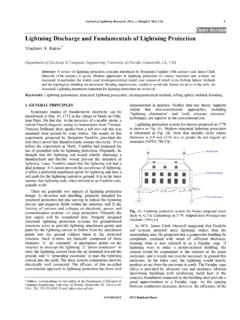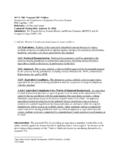Transcription of NFPN - lightning-risk.org
1 [i.) NFPN. National Fire protection Association ~1~ 113. International . 1 Batterymarch Park, Quincy, Massachusetts 02269-9101 USA. Telephone (617) 770-3000' Fax (617) 770-0700 I. I. (. Casey C. Grant, Secrerary. Srandard~~jl 9 May 2000. To: Interested Parties of early streamer . Emission (ESE) lightning protection Systems ~. Subject: Decision on Council Agenda Item 98-113 Date of Decision: 28 April 2000* Dear Interested Parties: At its 27-28 April 2000 meeting, the Standards Council considered agenda item 98-113. Attached is the final decision of the Standards ,Council on this matter. Sincerely, 145. Casey C. Grant, Secretary, NFPA Standards Council CCG/djb c: M. Brodoff, J. Caloggero, A. Cote, L. Nisbet, J. Shannon Members, TC'on-bi-ghtning protection Me~tbers, Stru:dards C~ , Interested Parties ~, /. NOTE: Participants in NFPA's codes and standards making process should know that in limited circumstances, review of this decision may be solight from the NFP A Board of Directors, For the rules describing these circumstances and the method for: petitioning the Board for review, please consult section I 7 of the NFPA Regulations Governing Committee Projects and the NFP A' Regulations Governing Petitions to the Board of Directors from Decisions of the Standards Council.]
2 Since this Council decision is not "related to the issuance of a document"as referenced in 1-7,2 of the Regulations Governing Committee Projects, notice of the intent to file such a petition must be submitted to the Clerk of the Board of Directors within a reasonable period oftime. An nonprofit membership organization dedicated to reducing the burden of fire on the quality of life by advocating code,s and siandards , resarch. and education for fire and related safety issues since 1896. Publishen of the National Fire Codes , including the National Electrical Code and the Life Safely Code", Standards Council Decision (Long Fonn): D#OO 13. Standards Council Agenda Item: . S C#98 113. Date of Decision: 28 April 2000. Subject: early streamer EmissIOn, (ESE) lightning protection Systems At its meeting, ,. the Standards ,Council held a hearing .to, reopen Jhe.'proceedings for consideration of the issuance' of a standard for early streamer Emission (ESE) lightning protection Systems in accordance with the 's Decision of October 8, 1998.
3 The lengthy background leading to this hearing has been summarized in previous Standards Council Decisions. (For the history of previous proceedings, see especially, the following Standards Council Decisions : October 14, 1993, Agenda Item ; January 12, 1994, D #94-11; July 18,1995, D #95-26; October 8, 1998, D #98-40. See also Appeals to the Board of Directors of May 3, 1994 and December 7, 1995. For related proceedings concerning NFPA 780, Standard for the ins tal/at ion ofLightning protection Systems, see the Standards Council Decision of July 18, 1995, D #95-25 and the Appeal to the Board of Directors of December 7, 1995.). The relevant history maybe sununarizOO as follows .. The TechniCal Committee on lightning protection Systems using early streamer Emission .Air Terminals waS formed in January 1991. ProposedNFPA 781, Standard fotLightning protection Using early streamer Emission Air Terminals, was published for public' review and comment in the 1993 Fall Meeting Technical Corrunittee Reports.
4 It was then presented to the 1993 Fan: Meeting in November of 1993, where the NFPA membership voted to return the document to committee. Following that meeting, a Complaint was made to the Standards Council requesting that the Council reject the vote of the association membership and instead, immediately issue proposed NFPA 781. The Council concluded that the vote of the membership recommending the return of the document to committee indicated that "the consensus necessary to issue the document has not yet been achieved." The Council further concluded that this lack of consensus derived from "genuine and legitimate questions on whether the early streamer emission technoiogy has been adequately demonstrated to be effective." The Council; therefore, defeITed ruling on the issuance of the proposed document in order to allow for an iridependentthird party review of the infonnation, currently available regarding 'the early streamer Emission (ESE) concept.
5 (See Standards Council Decision of January 12, 1994, D #94-11.). , . ------- Th~reafter, the Fire protection Research Foundation~ge<f for the NatiOhal. Institute of Standards and Teclmology (NIST)' to'perform the in~JYeildent third-party review req~ed by the Standards Council. NISI's final report became available in late April of 1995, ana---the Council convened a hearing, which took place' on July 18, 1995, to consider that report. Following the hearing, the Council issued a decision concluding that, based on th~ NIST report and other information which had been presented to the Council, the proposed NFP A 781 should not be issued. In arriving at this conclusion, the Council noted as follows: Proposed NFPA 7~,1 is based on the assumption that ESE tenninals provide a greater zone of protection than conventional tenninals. It was undisputed, SC l.>ecision #98-1 13!D#OO-13. Page 2 of 6. moreover, that proposed NFPA 781' would pemlltESE ~ystems using far fewer terminals and far greater.
6 Spacing between . terminals than in a comparable conventional system installed accordingtoNFPA 780 .. Given the absence of reliable evidence that those'ESEtemlinals offer an .increased zone of protection over that of conventional terininals; it seems cIearthat asoundtecrullcal basis for proposed NFPA 781 has not been demonstrated.. - . '\. The Council went on to p~mt 6utth(iJthe NIST report did not "invalidate the ESE concept, it merely concludes that the. evidence that ESE systems. provide meaningful enhancement over conventional systems has not been sufficiently developed." The Council noted that the report called for more research aimed at answering the many as yet .. unanswered questions about lightning in general and the ESE concept .in The Council concluded: Given the current state of knowledge, it does not appear that'the type of further research and evaluation recorrunended by the NIST Report Will be available in the short term.)
7 In the view of the Council, therefore, ' -corttinuingstandards development activities for ESE systems, wotild,at present, serve no useful purpose. Accordingly, the Council has voted .to discharge the Techrucal Committee on lightning Prote~tion Syst~ms Using early streamer Emission Air Terminals with appreciation for..In so doing, 'the . Council does not wish to imply that the NfPAis foreclosing future standarcts development in this or other new areas ofligliirungprotection .. Rather,it urges ' the proponents of this or any other lightning protecti<;>n technologies not currently served by NFPA 780 to petition the . Council whenever they believe that the case can be made that the technology has been sufficiently validated to permit meaningful standards development.. (See Standards. Council Decision of July 18, 1995, D. #95-26.). Three years later, in 1998, a representative of Heary Bros. lightning protection Co. Inc., lightning Preventor of America, Inc.
8 , and National lightning protection ,Corp. (the principal ESE. proponents), made a request to the .Standards Council asking the Council to reopen the proceedings for the issuance of a standard for ESE lightning protection .Systems, and to conduct a de novo review, reweighing and considering all evidence anew, including evidence not previously available. The request specifically soughtto have the Standards Council reopen the proceeding and reconsider the issuance of a standard for ESE lightning protection Systems along the lines set forth in a proposed settlement agreement which would resolve litigation by the requesting parties against the NFPA (Settlement AgreeQ1ent) .. In a Decision of October 8, 1998 CD #98-40), the Council voted to grant the request and .undertookto reopen thut-oceedings for consideration of the issuance of a standard for ESE LightIllng protection -SYs~s in fulfaccor-dC!Ilce with the tenns of the Settlement Agreement, a copy of which was made a part ofthe record.
9 Pursuant to the Council's decision and the terms of the Settlement Agreement, the Council authorized the creation of an independent panel t6 consider infonnation submitted by any interested persons and to issue a report concerning ESE lightning . protection technology to the ''-'' .. Standards Council. The panel was charged with addressing ,the following issues; and any other ", Sl Decision#98-113ID#OO-13. Page 3 of 6. issues it deemed relevant: (l) whether the ESE lightning protection technology is scientifically and technically sound; and (2) whether the ESE lightning protection technology is supported by adequate scientific theoretical basis and laboratory testing. As proposed by the principal ESE proponents and set forth in the Settlement Agreement, the panel was chaired by Dr. John , Dr. Bryan chose, as additional panel members, Richard Biermann and'" GlelUl Erickson. Aftersoliciting public input, the .Panel developed its Report (Bryan Panel Report), and the' Council received the Report.
10 At its meeting of September 30, 1999. The Council voted to make the Report, and any material submitted to the panel in connection with the Report, available for public review and comment and to hold a hearing at its April 27, 2000 meeting to consider the Report and related requests. That hearing has now taken place and, having reopened' the proceedings on the issuance of a standard for ESE lightning protection Systems, the Council' must;frrst' aod foremost, ' do what it agreed to do in its decision of October 8, 1998. Specifically the Council undertook under the tenns of the Settlement Agreement, to consider the issuance of a standard for ESE systems that would be "separate and distinct from NFPA 780." (Settlement Agreement at 1, f, pA) More specificaJly, the Agreement stated: The Standards Council will make the detennimition .in accordance with the NFPA's rules and regulations as to whether to issue an NFPA standard for. ESE. lightning protection technology.







